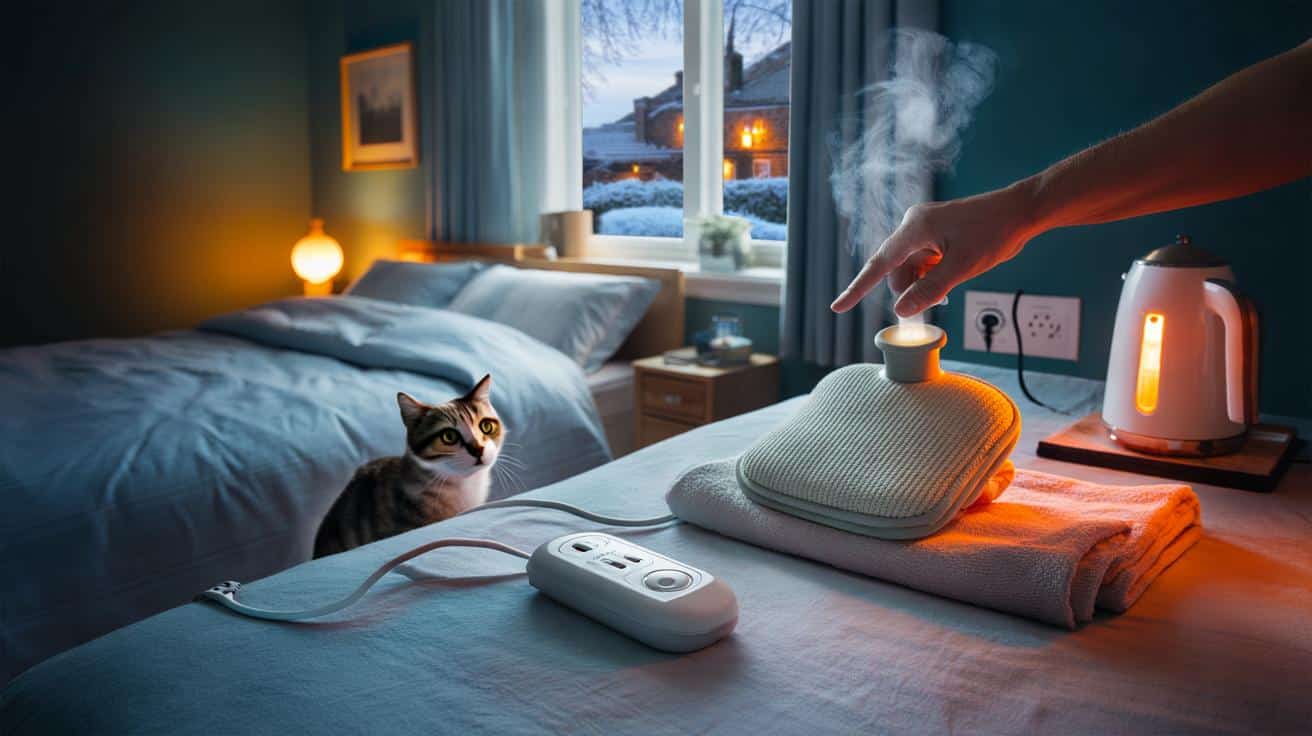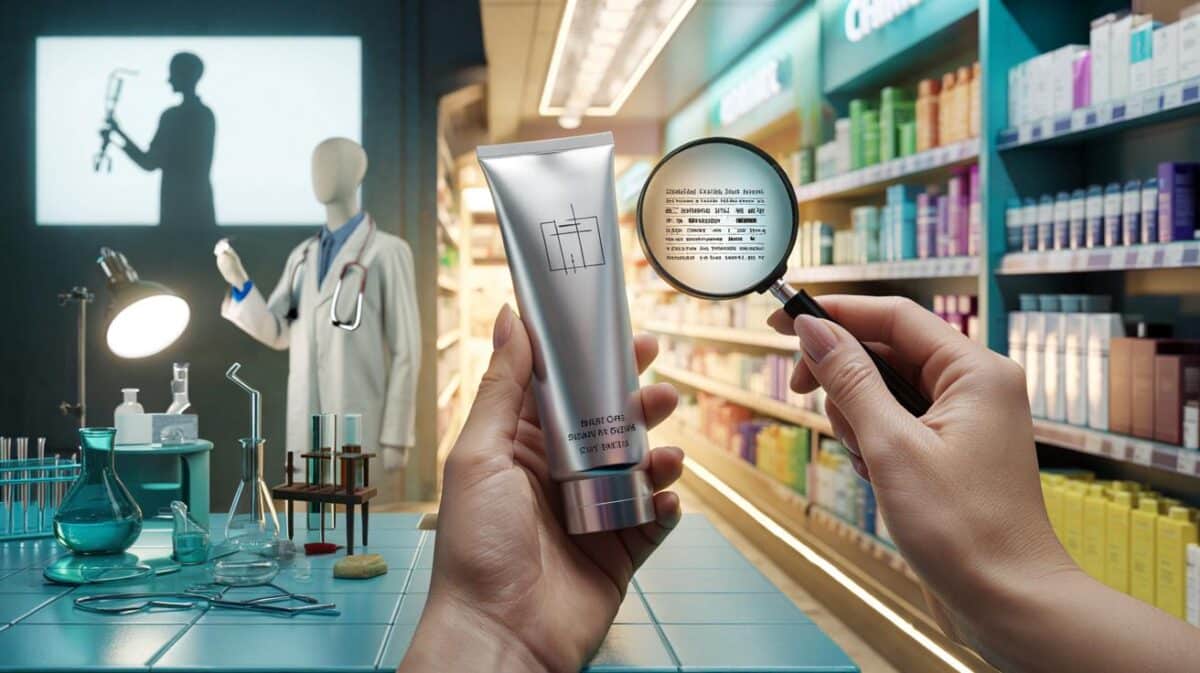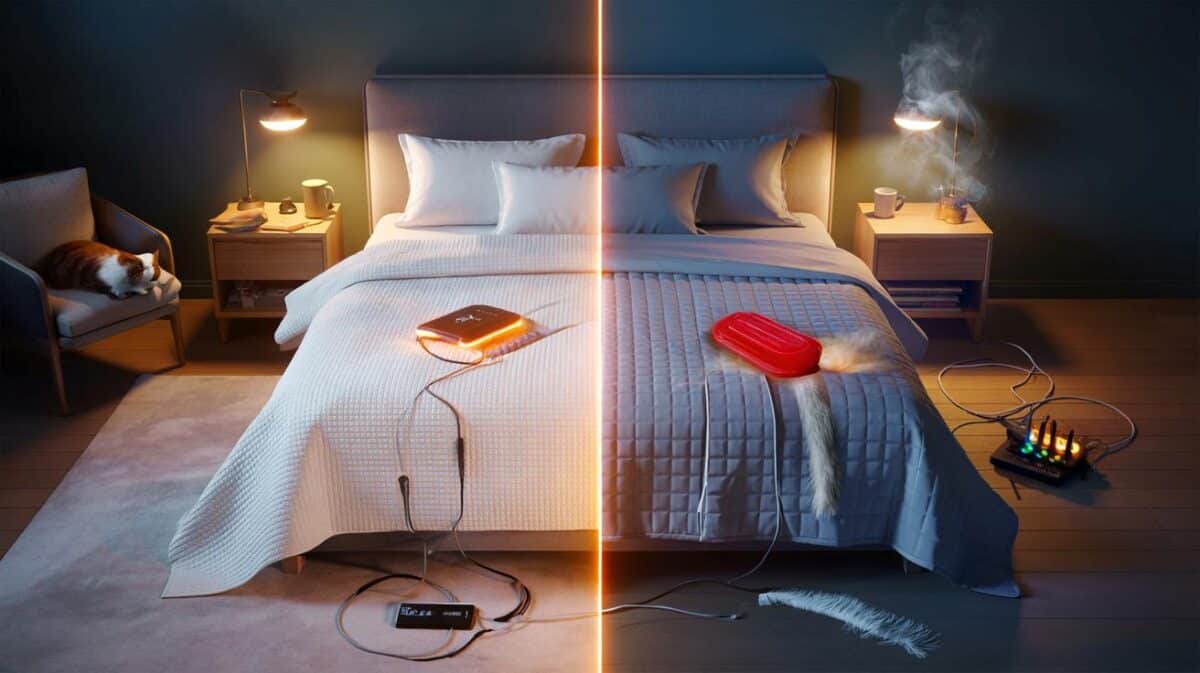One friend swears by her electric blanket, humming quietly under a king-size duvet; another clutches a hot water bottle like a small, glowing moon. The choice sounds cosy on the surface, yet it hides a real question: where is warmth safest when the temperature drops and the bills creep up?
I watched the first frost of the year from a terrace flat in Leeds, kettles starting their evening chorus up and down the block. In one window, a blue-ish glow marked the return of a heated throw; in another, someone banged a stubborn stopper against the sink, testing a bottle that looked older than the curtain rail. The air had that brittle, tinny feel that makes fingers clumsy and judgement a touch lazy. You want heat, now. You don’t want drama. A cat leapt onto a blanket and settled as if it owned the place. Steam drifted, cords twisted, somebody laughed at the weather. Then a quiet hiss cut through it.
Warmth isn’t just heat: it’s how it arrives, and what it risks
An electric blanket spreads a low, steady warmth that seeps into sheets and bones. A hot water bottle gives a bold, punctual heat, right where you place it, and fades from star-hot to lukewarm over an evening. One is hands-off once you set it, the other is a small ritual with a kettle and a twist of the wrist. That difference shapes safety as much as comfort.
A neighbour told me about a winter when her old bottle split at the seam. Not boiling, she said, but hot enough to lift skin and wreck a duvet. Another friend replaced his nan’s electric blanket after noticing a brown arc on the fabric and a plug that ran hot to the touch. We’ve all had that moment when warmth slips into worry, and the room goes very quiet.
When you zoom out, the risks aren’t equal. Hot water scalds fast, and stoppers, seams or tired rubber are the weak points. Electric blankets don’t splash, yet they bring wiring, heat elements and age into play. People with reduced sensation in their feet or legs face a different calculus, as do families with curious pets or toddlers who climb. Never use an electric blanket and a hot water bottle at the same time.
Safety-first, step-by-step: what to choose, how to use it well
Start with the label and the feel. For electric blankets, look for a UK plug, overheat protection, auto shut-off, and a clear British Standard mark (often BS EN 60335). The fabric should lie flat without hot spots, and the controller should click cleanly through settings. For hot water bottles, check for BS 1970 on the stamp, a date code, and a snug stopper that threads smoothly. If the rubber smells sharp or feels tacky, retire it. Hot, steady warmth begins with boring, honest checks done in good light.
Now the routine. Electric blankets like space: no folding, no pinching under heavy stacks, no tucking cords under pillows. Switch them off before sleep if the model hasn’t got a safe overnight mode. For bottles, fill with hot-not-boiling water, about two-thirds full, then expel air gently and secure the cap. Keep a cover between bottle and skin, and never rest full weight on it. Let’s be honest: nobody does that every single day. So set reminders, create a tiny ritual, and lower the chances of cutting corners when you’re tired.
Real homes have draughts, cats, and kids asking for “one more story.” That’s where good rules earn their keep rather than gather dust. Hot, not boiling, water only — always. Electric blankets need a yearly once-over for frayed edges, tired stitching, or discoloured patches along the wires. Bottles need replacing every couple of years, sooner if they crease or crack. If you’d rather not juggle a kettle at midnight, a modern heated throw on a low setting might be your friend.
“Warm is lovely. Safe warm is better,” said a fire officer who has seen what happens when fabric, heat and fatigue get too cosy with each other.
- Look for British Standards (BS EN 60335 for blankets, BS 1970 for bottles).
- Keep cords straight, bottles covered, and water below boiling.
- Don’t mix heat sources in the same bed.
- Replace ageing gear; store dry, uncapped and unfolded.
- If you have reduced sensation or fragile skin, choose low, even heat.
Which one tonight? It depends on your skin, your space, your rhythm
Some nights you want the blanket’s quiet, background hug, especially if you’re pre-warming a bed without cranking the radiators. Other nights, a bottle is perfect: a bright pulse for cold feet, stomach cramps, or a book on the sofa. Energy-wise, both beat heating the whole house; a blanket sips power across hours, a kettle gulps for a minute or two per fill, and the sums often come out similar across a week. Price caps shift, tariffs vary, and your habits will tip the scales. It’s less a gadget decision than a little pact with your winter routine.
Think about who shares your space. Pets love heat but chew cords and knead bottles, and small claws don’t care about seam integrity. Children nap unpredictably and roll, so safer choices lean toward low, fixed warmth under adult eyes. If grip strength or balance is an issue, lifting a kettle at arm’s length is not the one; a controller you click from the bedside is kinder. If you’re prone to dry skin or eczema, a hot, direct spot may flare things up, while gentle, spread-out warmth is kinder. Your comfort lives in these small, personal details.
Consider ageing too. If your blanket is older than your phone’s last contract, think twice. Wires fatigue. Controllers fail. Rubber perishes, even when it lives in a drawer. There’s a quiet dignity in admitting something has had its day. Trade nostalgia for reliability, and keep the story of your winter about films, soups and messages from friends, not scorch marks or scalds. Safety trumps speed, every single time.
| Key points | Detail | Reader Interest |
|---|---|---|
| Choose by risk profile | Steady, low heat vs. intense, local heat; think skin, mobility, pets, kids | Helps pick what fits your life tonight |
| Check the standards | BS EN 60335 for blankets, BS 1970 for bottles; retire tired gear | Practical, shoppable criteria |
| Ritual beats rush | Low settings, covers, no boiling water, no folding or mixing heat sources | Fewer scares, same cosy payoff |
FAQ :
- Can I sleep with an electric blanket on all night?Only if it’s designed for overnight use with overheat protection and a timer. Many people pre-warm the bed, then switch to a low setting or turn it off.
- Is a hot water bottle safe for children?Not for unsupervised sleep. Use warm (not hot) water, a cover, and place it away from direct skin contact. A heated throw on low, used while you’re present, may be simpler.
- Which is cheaper to run: electric blanket or bottle?Both are low-cost compared with heating a room. A blanket sips power steadily; a bottle costs the energy to boil the kettle. Your tariff and habits decide the winner.
- How often should I replace them?Electric blankets: check yearly and replace at the first signs of wear, or after around 7–10 years. Hot water bottles: replace every couple of years, sooner if the rubber creases, smells odd, or the stopper loosens.
- Can I use a bottle and an electric blanket together?No. Mixing heat sources in the same bed raises the risk of burns, leaks, and damage to the blanket’s wiring.








